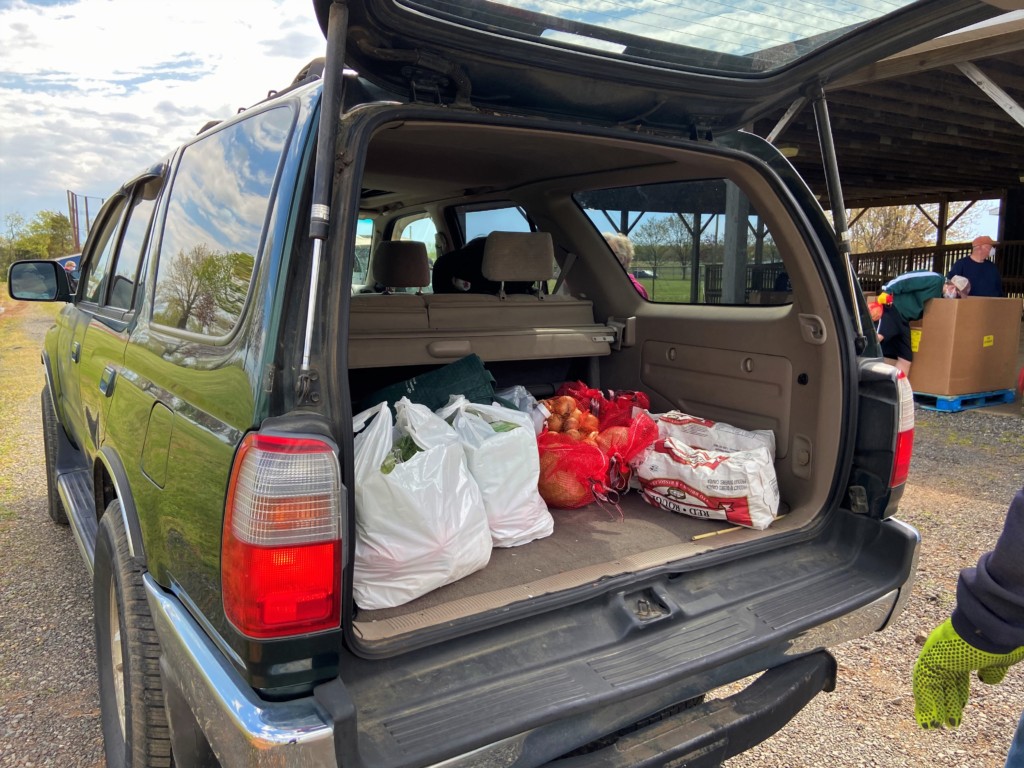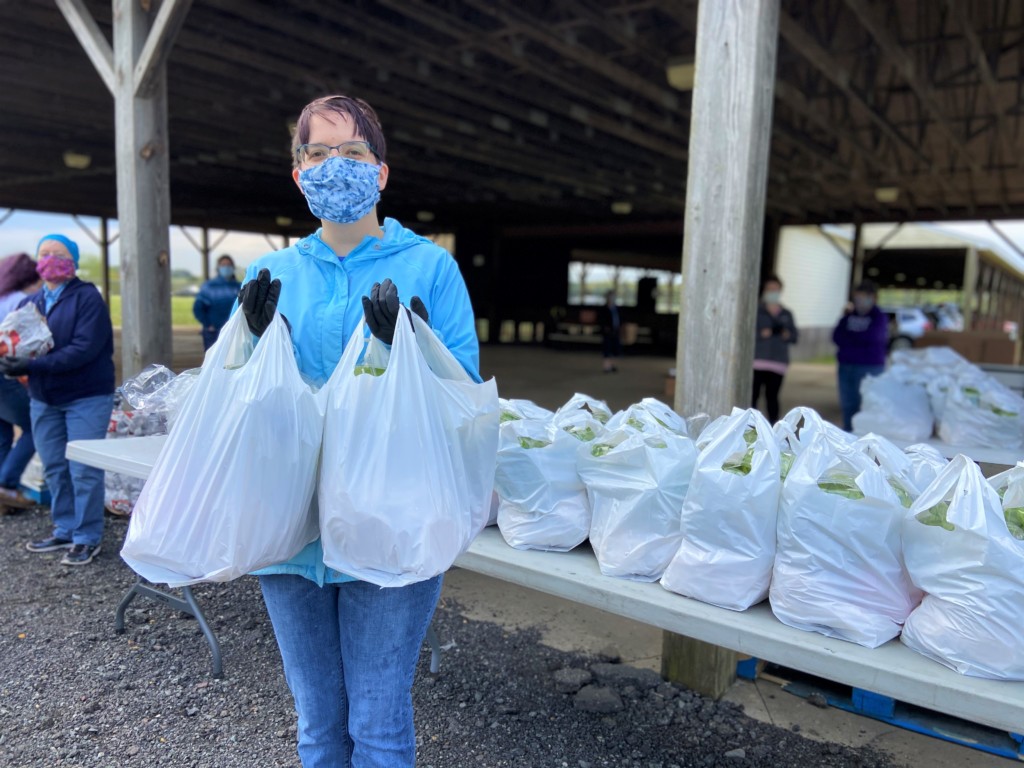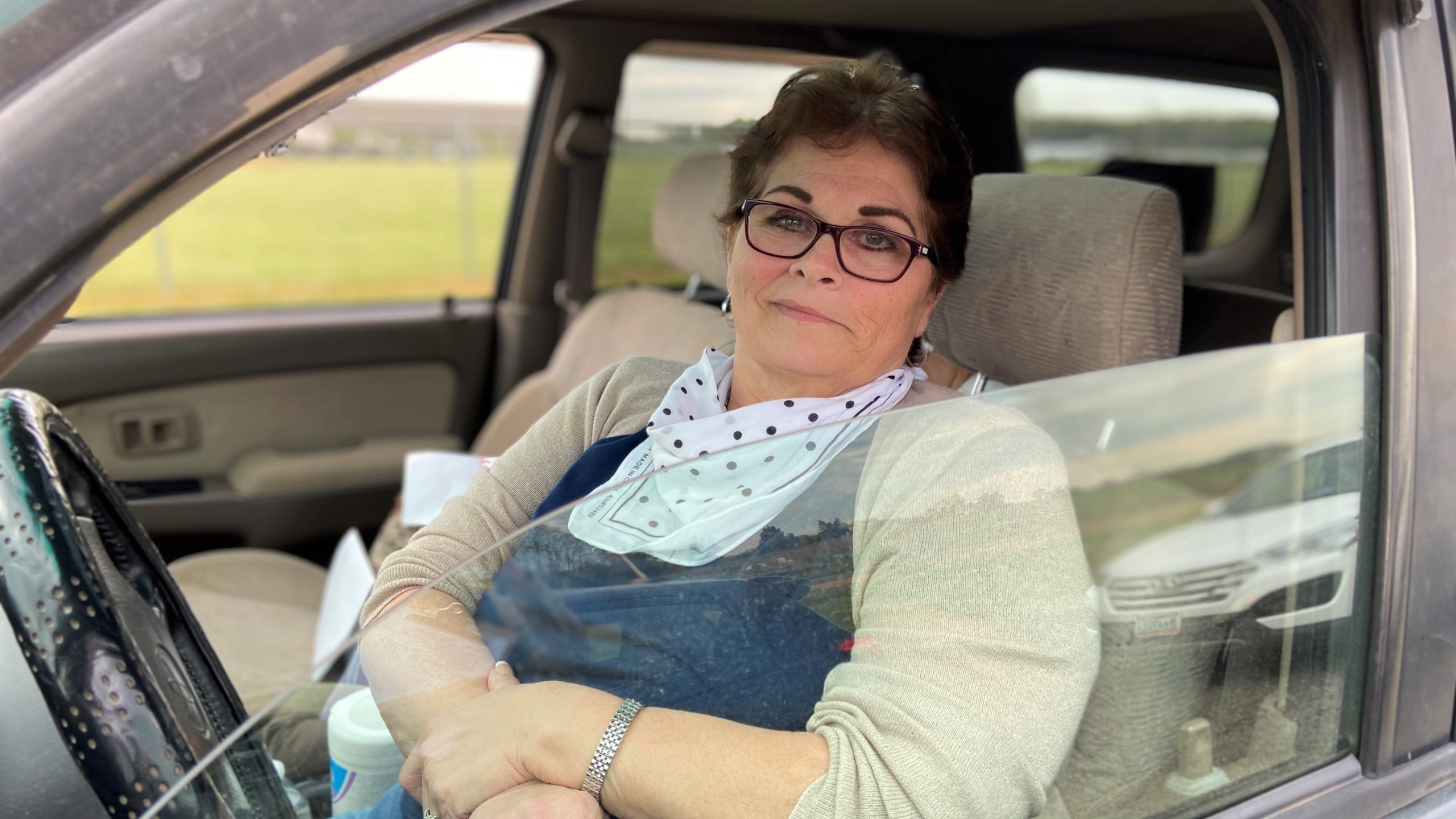A bustling street corner is the perfect spot to connect with neighbors “coming and going.” Karen, a first-time Food Bank client, knows this better than anyone: She just happens to live on one. “They call me the mayor,” she laughs. The polka-dot bandana around her neck adds an extra splash of spunk to her demeanor.
Even miles from her Locust Grove home, Karen’s deep community ties are on display. As she waits for the queue of cars to kick into motion at the Orange County Mobile Food Pantry distribution, she mentions her friend in line right behind her. Later, she tosses a gleeful greeting through her cracked window when a neighbor’s truck putters up beside her.
Just as she’s deeply rooted in her community, Karen is an active member of her sizable family. She has two elderly parents, three kids, and 13 grandkids, and she shares her home with four others—including a granddaughter. And today, for her first-ever Mobile Food Pantry outing, she’s brought along her five-year-old, Barbie-loving grandchild, who chatters happily in the backseat with her best friend. (It was her granddaughter’s HeadStart teacher who pointed Karen to the distribution.)
This April, the national unemployment rate skyrocketed to a historic level. And with this surge came an increased need for food assistance—in many cases, for people who’d never sought it before. Leading up to the crisis, the Food Bank could expect to serve about 1,600 new clients every six weeks. But between March 1 and April 15, this count nearly tripled, peaking at 4,400 individuals.
Life hasn’t always been easy for Karen, but the rise of COVID-19 marked a serious turning point for her and her family. After being rear-ended by a drunk driver in 2013, she was left with her face partly paralyzed. “I live with pain,” she says, adding that when the spread of the coronavirus forced school closures, she started to worry: How would she feed her loved ones? The pandemic piled fresh challenges on top of the pre-existing ones.
#SeniorHungerAwareness
Karen’s concern doesn’t end with her own household. She worries about her parents, too, who—after paying for costly medications—live on about $600 in remaining Social Security funds each month. In addition to supplying kerosene or wood, Karen often brings them food. (She wants to help them like they helped her when she was young.) But her budget is thin, so “they get hamburger or hotdogs.”
According to the Centers for Disease Control and Prevention (CDC), a projected 5.5 million seniors experience hunger. As a result, these individuals are more likely to live with poor health, which, in turn, puts them at greater risk of contracting COVID-19. The crisis is making it more difficult than ever for these seniors to access the nutritious food they need, especially as they respond to guidance to “stay home.”
When Karen learns she can secure food for her parents at the Mobile Food Pantry, a wave of relief washes over her body. “I wish I’d known about it sooner!” she exclaims. She connects with volunteers to log her parents in the Food Bank database and coordinate the pickup. In total, 160-plus seniors are served on this day, in addition to 213 children, 299 younger adults, and 226 families.
Combating hunger—and social stigma, too

What would Karen say to others in need of food?
“People don’t want to say they have need,” she stresses, but “it’s not a sin or a sign of weakness to ask for help.” She references the wave of Americans who’ve lost their jobs as a result of the crisis. “You need to lose your pride.”
The Food Bank is not only working to spread awareness about the availability of food assistance across central and western Virginia—especially by reaching folks who’ve never needed this kind of help before—but it’s responding to particularly vulnerable populations. In addition to developing strategies to aid children, seniors, and homebound individuals, the Food Bank seeks to help workers without unemployment insurance, including undocumented individuals.
“No one should feel stigmatized … There are 30 million people in the country who are suddenly out of work. This is a very big boat we’re all in. Don’t worry about the appearance of it—get the help you need to provide food for your family.”
–Michael McKee, Food Bank CEO
Looking toward the future with hope
Even though the days ahead are uncertain, Karen still finds time to smile. In particular, she enjoys thinking dreamily about her large backyard, in which she plans to plant a garden. “I love playing in the dirt,” she says.

This is a testament to the resilience of the human spirit: When the going gets tough, people adapt, all while finding ways to lean into the places and people they love most.
And the Food Bank is no different—our operations are shifting rapidly to meet the needs of the community for which we so fervently care. We’re moving and buying more food than ever. Last month alone, we distributed 2.9 million pounds of food, marking a 13.7% year-over-year increase in April totals. And as grocery stores cut back on donations, we’re filling the gap by drastically increasing the amount of food we’re purchasing. In just six weeks, we’ve spent $1.3 million on food, thanks to the backing of generous donors.
The Food Bank remains inspired by the outpouring of support it continues to receive, in the form of time, funds, and voices donated. And despite not fully knowing what lies ahead, we’re walking forward buoyed by hope.

